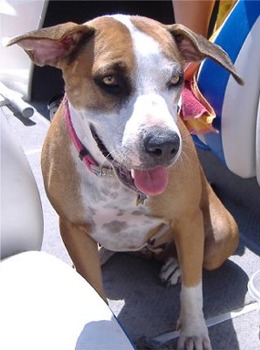INSTANT PROMOTION - LIMITED TIME OFFER - GET YOUR PUPPY COUPON TODAY
Hicksville: 516-938-7877
Lynbrook: 516-825-7877
Hicksville: 516-938-7877
Lynbrook: 516-825-7877
Currently we do not have any Catahoula Leopard Dog Puppies available.
Please complete the form below to be notified when they are back in our stores.

Height: 20 – 26 inches. Weight: There are three different lines of Catahoula, from which three different weights come into play. The Wright line is from 90 – 110 lbs. The Fairbanks line is from 65 – 70 lbs. And the McMillin line is from 50 – 60 lbs. All have been crossed with each other, creating the variety we have today.
Colors: Blue leopard, red leopard, black, red, yellow, and brindle. Tan and/or white trim may be present. The coat can be any color or pattern. It is often patchy, brindled, or leopard. The eyes can be any color or combination of colors, including blue. The colors come from distinct lines of the breed. The Wright line descended from the original Spanish explorer Hernando de Soto’s dogs. The brindle to yellow colored dogs were from the Fairbanks line, and the blue leopard color and glassy eyes came from the McMillin line. All have been crossed with each other. Coat: Short, smooth and dense. Can be medium length.
Temperament: Catahoula Leopard Dogs are assertive, strong, workaholic dogs. They are affectionate and playful with their owners, but remain wary of strangers. They are very protective and not afraid of a fight, in fact they like to pick fights with quarry. They generally get along with children, but should be supervised. They are more tough than most other shepherd dogs, as they heel harder and are more aggressive with livestock. Best used for wild animals, this breed may have red wolf blood. They are dominant, strong-willed and serve as pack leaders. With Children: Good with children if socialized early on. They tend to be fine with kids, but supervision is best. With Pets: Can be aggressive toward dogs of the same sex, or dogs in general. Training and socialization are essential to live with other pets.
Watch-dog: Very High. Guard-dog: Very High, will vigorously protect their owner and their territory. They tend to be aggressive towards other dogs, especially of the same sex. They are not always friendly towards strangers, either.
Care and Training: Minimal grooming. Catahoulas require a lot of exercise the minimum should be a run for a full hour daily. A good exercise would be herding, treeing, or some other activity that requires them to run. Special Needs: Exercise, training, an activity or job to do, socialization and supervision. Learning Rate: Very High. They are very intelligent.
Activity: Very High. Catahoulas need to do a job or activity to release constant energy. Living Environment: This breed is suited for life on the farm or ranch, if the Catahoula Leopard Dog is to live in city they need an outlet for their abundant energy and workaholic personality. These dogs are not suitable for any owner, as they can be aggressive towards other dogs, protective, and tend to be independent. The best owner for this type of dog is someone who is a dog-experienced, firm and active person living in a rural or possibly suburban home.
Health Issues: This breed is mostly healthy and generally free of diseases. Dogs with primarily white coats have an 80% chance of deafness in one or both ears, and/or blindness. Other dogs have had problems with tunnel vision and abnormal pupils, as well as hip dysplasia.
Life Span: 10 – 14 years. Litter Size: 8 – 12 puppies.
Country of Origin: United States History: In 1686, Henri De Tonti recorded seeing dogs with mottled spots and white eyes while he was exploring. The name of the Catahoula comes from the Parish of Catahoula. The word “Catahoula” is a corrupted version of the word for “beautiful clear water” in the Choctaw Native American language. Catahoulas are thought to descend from “war dogs” (mastiff and greyhound types) brought to America by Spanish explorers. One of these explorers, Hernando de Soto, was reported to have set these dogs to attack Indians, and then abandoned them with their victims. Some of these dogs that were left behind bred with dogs belonging to the Indians, which may have been domesticated red wolves, and later with settlers’ dogs. Some believe the Beauceron had a part to play in the “Cat’s” genetic makeup. The Catahoula was used by settlers to drive out wild animals, especially boars, from the forest and into the settler’s pen. Flushing boars from the woods was difficult, and most shepherd dogs could not achieve this goal. But the Catahoula proved its worthiness when instead of herding the pigs out of the forest, it would irritate the hog so much that it would pick a fight with it. The hogs would scream at the dog, drawing more pigs to scene, and eventually the pigs would run after the dog who would in turn run into the owner’s pen. The dog could easily jump the fence, the owner would close the gate, and the pigs would be trapped. Catahoulas were also used to locate cattle in a storm, as they could “wind” cattle, or find them by scent. A bit of hound’s blood may have also been in the Cat’s genealogy. In 1979, the Catahoula Leopard Dog was named the state dog of Louisiana. They are not yet recognized by the AKC, but yield a number of supporters in the National Association of Louisiana Catahoulas.
First Registered by the AKC: FSS (AKC Foundation Stock Service – not yet eligible for the AKC) Class: Herding Registries: NALC, SKC, ARBA, UKC